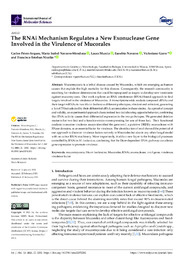Título :
The RNAi Mechanism Regulates a New Exonuclease Gene Involved in the Virulence of Mucorales |
Autor :
Navarro-Mendoza, María Isabel 
Pérez-Arques, Carlos 
Murcia, Laura
Navarro, Eusebio 
Garre, Victoriano 
Esteban Nicolás, Francisco |
Editor :
MDPI |
Departamento:
Departamentos de la UMH::Producción Vegetal y Microbiología |
Fecha de publicación:
2021-02 |
URI :
https://hdl.handle.net/11000/35291 |
Resumen :
Mucormycosis is a lethal disease caused by Mucorales, which are emerging as human
causes that explain the high mortality for this disease. Consequently, the research community is
searching for virulence determinants that could be repurposed as targets to develop new treatments
against mucormycosis. Our work explores an RNA interference (RNAi)-based approach to find
targets involved in the virulence of Mucorales. A transcriptomewide analysis compared sRNAs and
their target mRNAs in two Mucor lusitanicus different pathotypes, virulent and avirulent, generating
a list of 75 loci selected by their differential sRNA accumulation in these strains. As a proof of concept
and validity, an experimental approach characterized two loci showing opposite behavior, confirming
that RNAi activity causes their differential expression in the two pathotypes. We generated deletion
mutants for two loci and a knockin-strain overexpressing for one of these loci. Their functional
analysis in murine virulence assays identified the gene wex1, a putative DEDDy exonuclease with
RNase domains, as an essential factor for virulence. The identification of wex1 showed the potential of
our approach to discover virulence factors not only in Mucorales but also in any other fungal model
with an active RNAi machinery. More importantly, it adds a new layer to the biological processes
controlled by RNAi in M. lusitanicus, confirming that the Dicer-dependent RNAi pathway can silence
gene expression to promote virulence.
|
Palabras clave/Materias:
mucormycosis
Mucor lusitanicus
Mucorales
RNAi
exonuclease
wex1 gene
virulence
virulence factor |
Tipo de documento :
info:eu-repo/semantics/article |
Derechos de acceso:
info:eu-repo/semantics/openAccess
Attribution-NonCommercial-NoDerivatives 4.0 Internacional |
DOI :
https://doi.org/10.3390/ijms22052282 |
Publicado en:
Int. J. Mol. Sci. 2021, 22(5), 2282 |
Aparece en las colecciones:
Artículos - Producción vegetal y microbiología
|
 La licencia se describe como: Atribución-NonComercial-NoDerivada 4.0 Internacional.
La licencia se describe como: Atribución-NonComercial-NoDerivada 4.0 Internacional.
.png)
